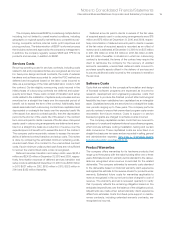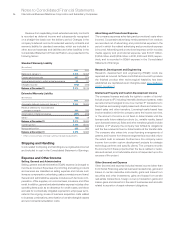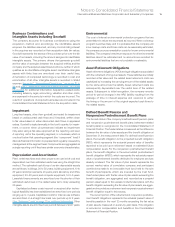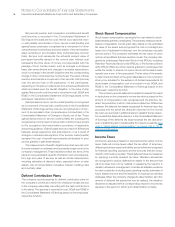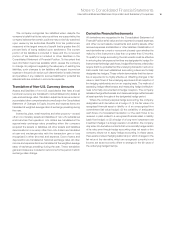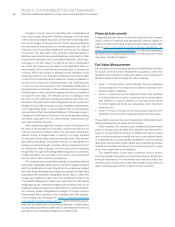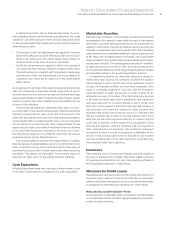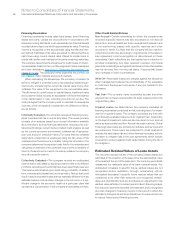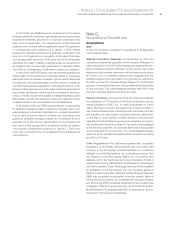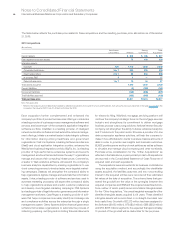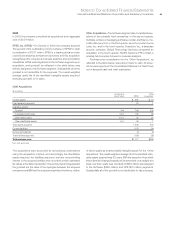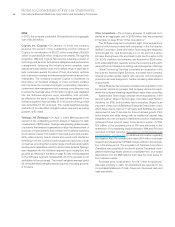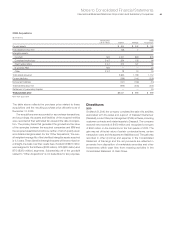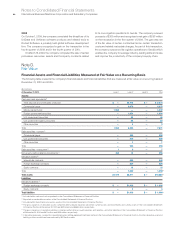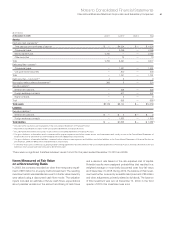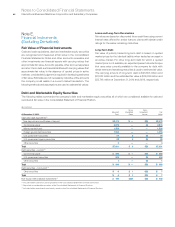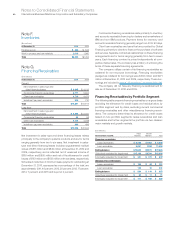IBM 2010 Annual Report Download - page 82
Download and view the complete annual report
Please find page 82 of the 2010 IBM annual report below. You can navigate through the pages in the report by either clicking on the pages listed below, or by using the keyword search tool below to find specific information within the annual report.
Notes to Consolidated Financial Statements
International Business Machines Corporation and Subsidiary Companies80
Also, in October 2009, the FASB issued guidance which
amended the scope of existing software revenue recognition
guidance. Tangible products containing software components and
non-software components that function together to deliver the
tangible product’s essential functionality are no longer within the
scope of software revenue recognition guidance and are accounted
for based on other applicable revenue recognition guidance. In
addition, the amendments require that hardware components of a
tangible product containing software components are always
excluded from the software revenue recognition guidance. This
guidance must be adopted in the same period that the company
adopts the amended guidance for arrangements with multiple
deliverables described in the preceding paragraph. Therefore,
the company elected to early adopt this guidance as of January 1,
2010 on a prospective basis for all new or materially modified
arrangements entered into on or after that date. The adoption of
this guidance did not have a material impact in the Consolidated
Financial Statements.
For transactions entered into prior to January 1, 2010, the com-
pany recognized revenue based on established revenue recognition
guidance as it related to the elements within the arrangement. For
the vast majority of the company’s arrangements involving multiple
deliverables, the fee from the arrangement was allocated to each
respective element based on its relative fair value, using VSOE. In
the limited circumstances when the company was not able to
determine VSOE for all of the elements of the arrangement, but
was able to obtain VSOE for any undelivered elements, revenue
was allocated using the residual method. Under the residual
method, the amount of revenue allocated to delivered elements
equaled the total arrangement consideration less the aggregate
fair value of any undelivered elements, and no revenue was recog-
nized until all elements without VSOE had been delivered. If VSOE
of any undelivered items did not exist, revenue from the entire
arrangement was initially deferred and recognized at the earlier of:
(i) delivery of those elements for which VSOE did not exist or (ii)
when VSOE was established. The residual method and recognition
of revenue on a ratable basis were generally used in circumstances
where VSOE, as applicable, was unavailable.
If the new amended accounting standards for multiple-deliver-
able arrangements and the changes to the scope of existing soft-
ware revenue recognition guidance were applied to transactions
in the year ended December 31, 2009, it would not have resulted
in a material change to the company’s reported revenue for that
fiscal year.
In addition, there would not have been a material impact
to revenue, as reported for the year ended December 31, 2010, if
the transactions entered into or materially modified on or after
January 1, 2010 were subject to the previous accounting guidance.
In terms of the timing and pattern of revenue recognition, the new
accounting guidance for revenue recognition is not expected to
have a material impact on revenue in future periods.
In June 2009, the FASB issued amendments to the accounting
rules for variable interest entities (VIEs). The new guidance eliminates
the quantitative approach previously required for determining
the primary beneficiary of a variable interest entity and requires
ongoing qualitative reassessments of whether an enterprise is the
primary beneficiary. The company adopted these amendments for
the interim and annual reporting periods beginning on January 1,
2010. The adoption of these amendments did not have a material
impact in the Consolidated Financial Statements.
In September 2009, the FASB issued amended guidance
concerning fair value measurements of investments in certain
entities that calculate net asset value per share (or its equivalent). If
fair value is not readily determinable, the amended guidance permits,
as a practical expedient, a reporting entity to measure the fair value
of an investment using the net asset value per share (or its equivalent)
provided by the investee without further adjustment. In accordance
with the guidance, the company adopted these amendments for
the year ended December 31, 2009. There was no material impact
in the Consolidated Financial Statements.
In May 2009, the FASB issued guidelines on subsequent event
accounting which sets forth: 1) the period after the balance sheet
date during which management of a reporting entity should eval-
uate events or transactions that may occur for potential recognition
or disclosure in the financial statements; 2) the circumstances
under which an entity should recognize events or transactions
occurring after the balance sheet date in its financial statements;
and 3) the disclosures that an entity should make about events or
transactions that occurred after the balance sheet date. These
guidelines were effective for interim and annual periods ending
after June 15, 2009, and the company adopted them in the quarter
ended June 30, 2009. In February 2010, the guidance was
amended to remove the requirement to disclose the date through
which subsequent events were evaluated. There was no impact
in the consolidated financial results.
On January 1, 2009, the company adopted the revised FASB
guidance regarding business combinations which was required to
be applied to business combinations on a prospective basis. The
revised guidance requires that the acquisition method of accounting
be applied to a broader set of business combinations, amends
the definition of a business combination, provides a definition of a
business, requires an acquirer to recognize an acquired business
at its fair value at the acquisition date, and requires the assets and
liabilities assumed in a business combination to be measured and
recognized at their fair values as of the acquisition date (with limited
exceptions). There was no impact upon adoption and the effects
of this guidance depend on the nature and significance of business
combinations occurring after the effective date. See note C,
“Acquisitions/Divestitures”, on pages 81 to 86 for further information.



